How comfortable are real people with using voice commands on their devices?
For the third year in a row, we asked over 1,000 people (1,719 this year) how they use voice, when they use voice, and why. If you’re looking to get a snapshot of how voice is used by people today, then you’ve found it.
Why do we care? It’s simple: The voice revolution is coming, and it’s coming fast. In just a few years, it’s likely that you will spend as much, or more, time interacting with devices that have no screen as you do with devices that have screens, such as laptops and smartphones. This has the potential to drive huge changes in the market, including new winners and losers—and you want to be one of the winners. (Well, I know I do!)
For reference, here are links to the two prior versions of his study:
For many of the survey questions shown as bar charts, we asked participants to rate whether or not they are willing to do something on the following scale:
- Very Likely
- Likely
- Neutral
- Unlikely
- Very Unlikely
Unless specified otherwise, these charts show the totals of the “Very Likely” and “Likely” responses.
In addition, for many of the other survey questions shown as bar charts, we asked participants to answer how often they do something as follows:
- Very Frequently
- Frequently
- Occasionally
- Rarely
- Never
Unless specified otherwise, these charts show the totals of the “Very Frequently” and “Frequently” responses.
In What Environments Do People Use Voice?
This block of 12 questions is meant to break down how various public and private situations impact people’s willingness to use voice commands. This data reveals the general trend for voice usage over time. The message from the data is clear: People’s comfort with using voice commands with their devices is growing.
In particular, using voice commands with devices in front of others, including in public, continues to grow at a significant clip. This documents what you might expect – as more and more devices become voice enabled, the stigma with talking to your devices (such as a smartphone) is disappearing.
Here is a look across all survey participants:
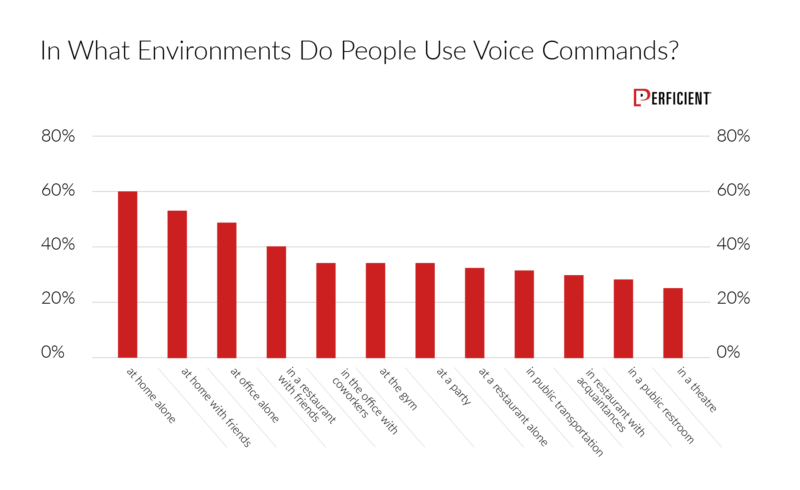
Note that the prevalence of speaking to devices “In a Public Restroom” (27.8%) and “In a Theater” (26.1%) seem stunningly high. How did these numbers change from last year? Well, let’s take a look:
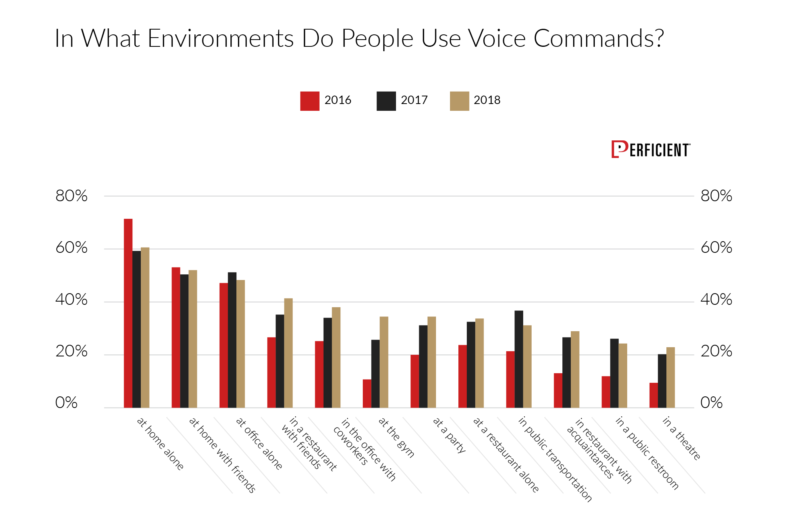
2018 was up in 10 out of the 12 categories over 2018. The only exceptions were “In the Office” (51% to 49%) alone and “On Public Transportation” (dropped from 36% to 30%).
However, on the other side of things, “In a Restaurant with Friends,” “At the Gym,” “At a Party,” and “In a Theater” were all up by more than 3%. And that all important “In a Public Restroom” category was also up from 25% to 28%.
We also measured how men and women differ with regard to using voice commands. Just as the prior two years’ survey showed, we still see that men are far more likely to use voice with their devices:
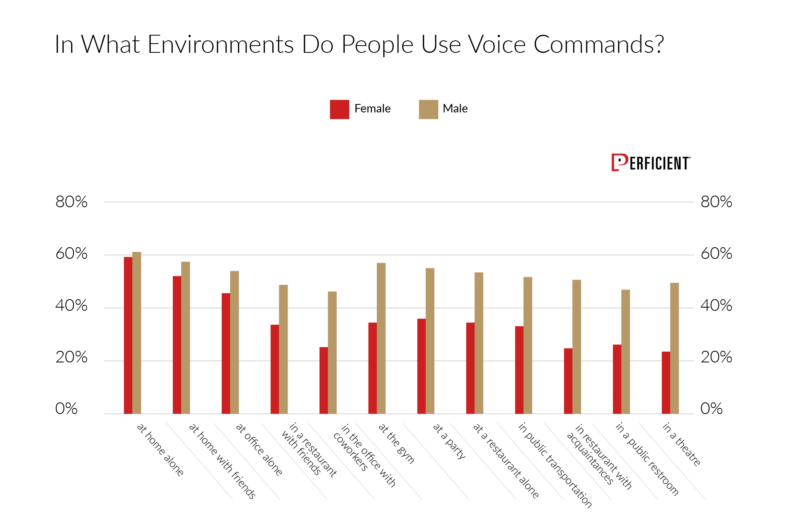 This gap looks to be about the same last year, where men were 1.59 times more likely to use voice than women. In our 2019 data that was 1.54 times.
This gap looks to be about the same last year, where men were 1.59 times more likely to use voice than women. In our 2019 data that was 1.54 times.
Data from 2017, men were 1.43 times more likely to use voice than women. This year that rose to 1.54 times.
Next up, let’s examine how age influences the level of usage. Here is what we saw:
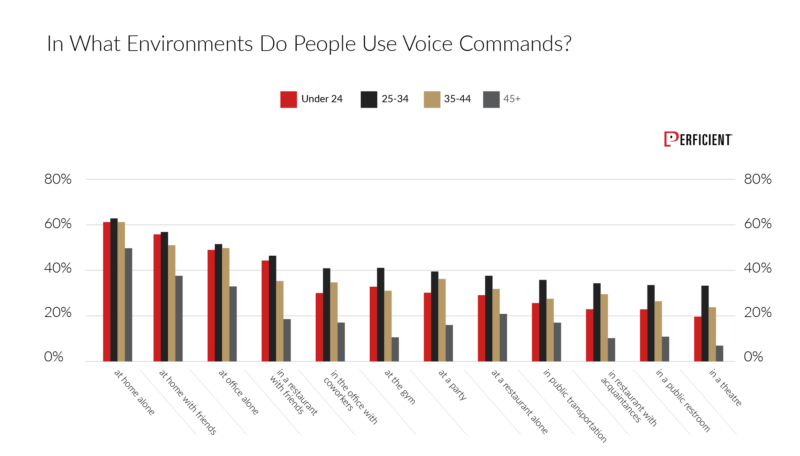
For the second year in a row, the 25-34 age group was the most likely to use voice commands with their smartphone, and they were 20% more likely to be comfortable using voice with their device than the youngest age category of 24 and under.
Marital status also seems to matter. Here’s a look at the data:
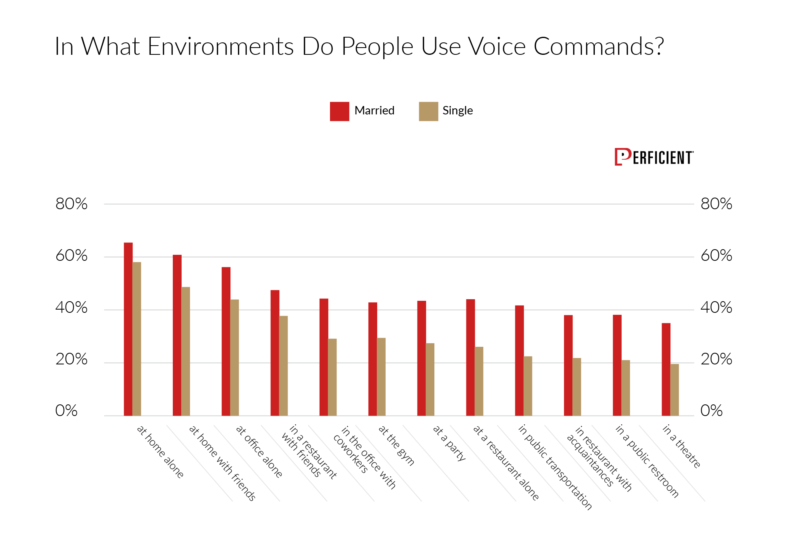 Married people are more likely to use voice in every single category. Married people were 1.46 times more likely to use voice than those that are single, up from last year’s 1.12 times.
Married people are more likely to use voice in every single category. Married people were 1.46 times more likely to use voice than those that are single, up from last year’s 1.12 times.
For the third year in a row we captured income levels of the participants. Here is what we got:
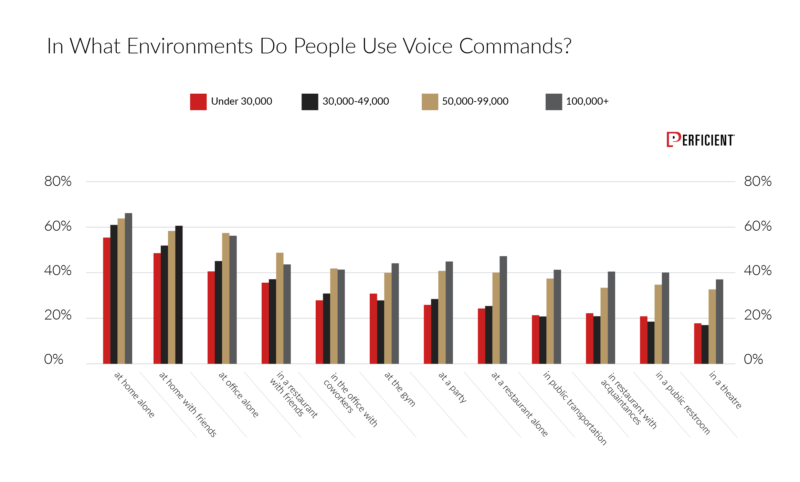
Just as in 2017 and 2018, the $50K -$99K and $100K+ income categories were the most likely to use voice with their smartphone, with the $100K+ earners having the edge by a 47.5% to 44.9% margin.
New to this year’s survey, we captured information on the region where people are located. Let’s see how this impacts voice usage levels:
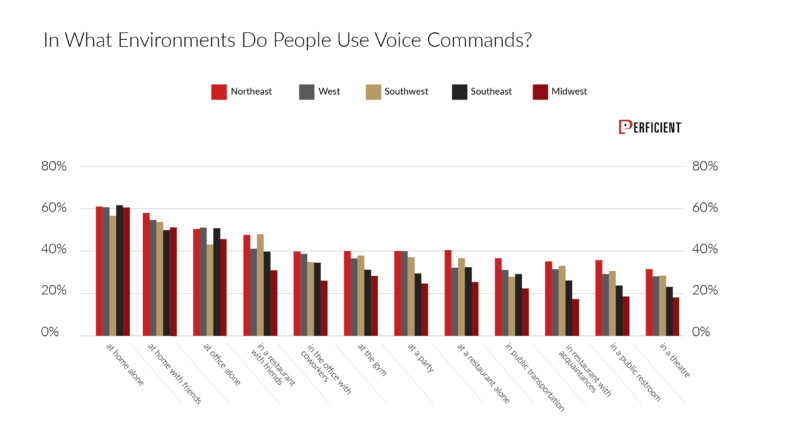 If we aggregate all these categories, we can see what region is most likely to use voice commands. Here are the regional rankings:
If we aggregate all these categories, we can see what region is most likely to use voice commands. Here are the regional rankings:
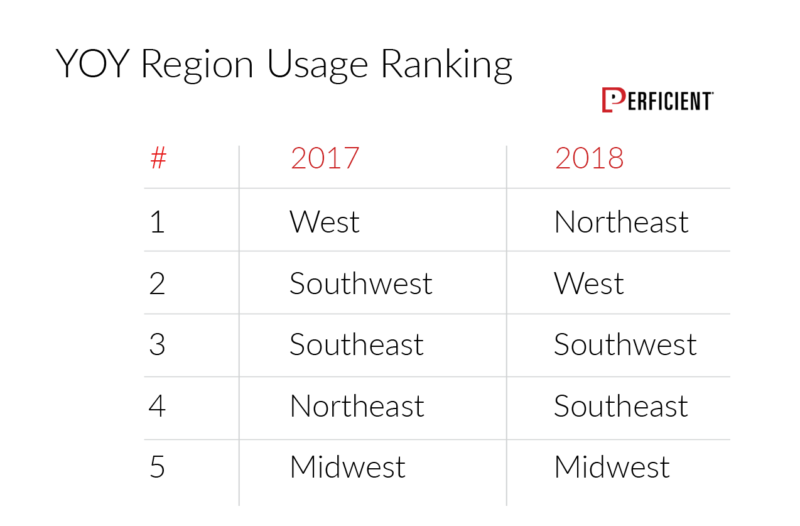
It’s not entirely surprising that the top two regions for voice usage are the Northeast and the West. Of note, 35% of people in the West use voice commands in public restrooms. The Midwest ranked last in eight of the 12 categories.
For the second year in a row, we captured information on the education level of the participants. Here’s the data from 2019:
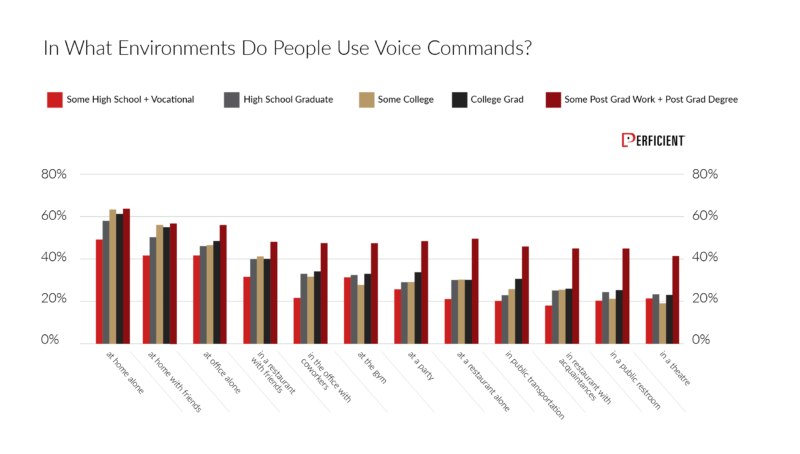
It looks like people who have done some postgraduate work and those who have a postgraduate degree are the heaviest users. In fact, voice usage seems to scale with education level:
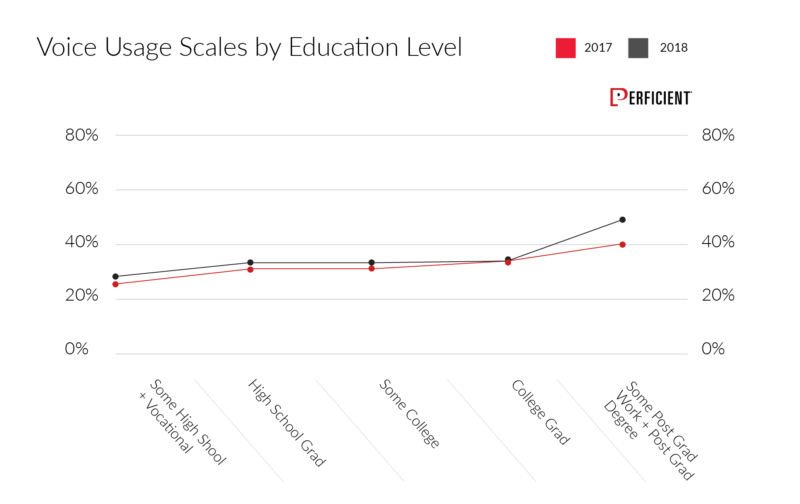
As you can see, in both 2017 and 2018, the comfort with using voice commands goes up as education goes up. In addition, 2019 levels of comfort were up across the board, with a very noticeable leap upward for those with some post grad work or a post graduate degree. This is consistent with the trend towards higher income groups being heavier users of voice.
How People Use Voice with Their Smartphones
In this next section, we explore how people use voice, as well as other ways they interact with their smartphones.
Our first question explored how people conduct searches. The phrasing was, “When I need to look up information, I am most likely to … (Please rank your top three choices).” These are the choices we gave them:
- Use voice search
- Type the question into the search window of my phone
- Type the question into search engine apps
- Open a mobile browser such as Safari or Google Chrome, and type the question
- Ask a friend via text or messaging app
We asked them to select their “First Choice,” “Second Choice” or “Third Choice.” Two choices remained unranked for each participant. First, let’s look at the breakout of what people said was their “First Choice” for how to use their phone to perform a search:
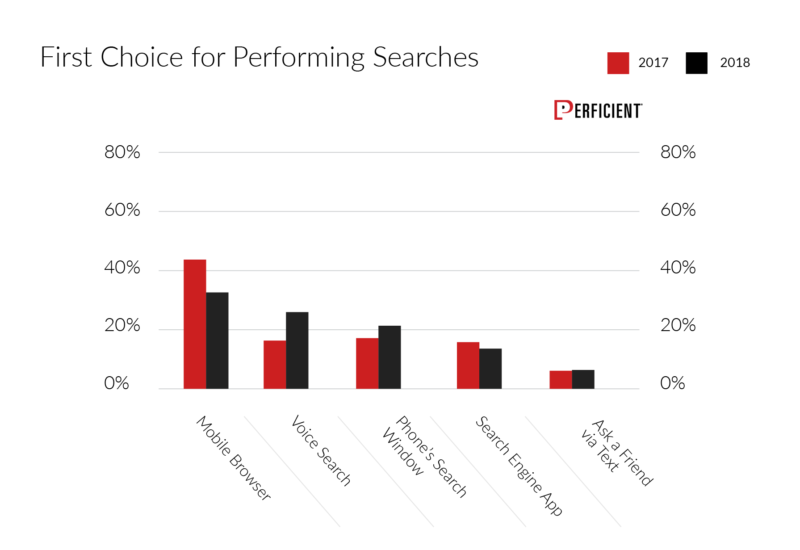
Mobile browser remains the leader here, but voice search made a big leap upwards in 2018. Next, let’s look at the distribution of what people selected across all three of their choices:

Even though voice search was second most common “First Choice” for users, it only placed fourth overall. That suggests that those who engage with voice search at all often consider it their top choice.
Taking a deeper look at texting and messaging, you can see a clear trend of usage by age, as shown in this graph:
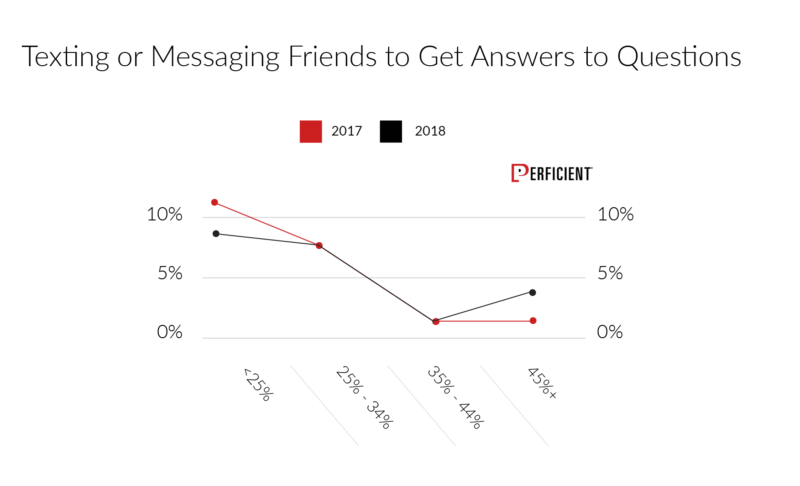
This chart reflects the selection of texting/messaging apps as a first choice. While the total texting usage level is down, you can see that this skews heavily towards those that are younger.
There is actually some real interaction between these two trends.
In the next question we asked people, “Which of these applications have you controlled with voice commands? (Please select all that apply).” Responses were as follows:
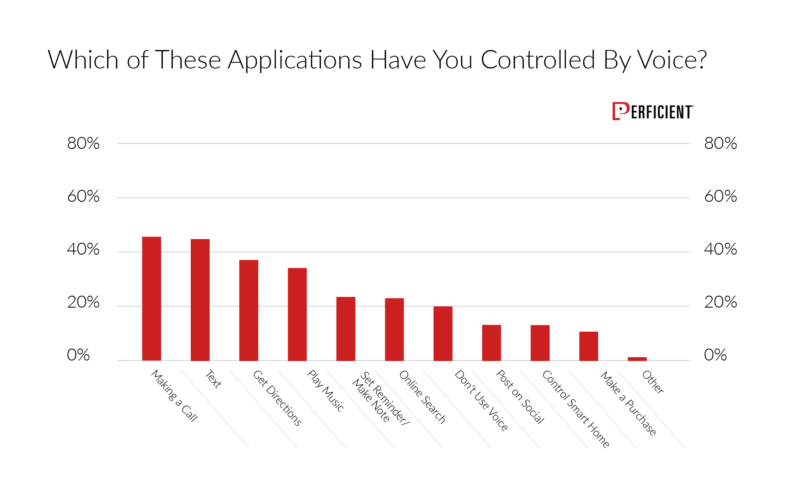
In 2018, texting came in at 56% as the number one app that people use voice for. While this dropped into the number two spot in 2019, it still comes in at a strong 44%. The number one application is making phone calls. Also of interest is that men are higher in usage than women in all but two applications:
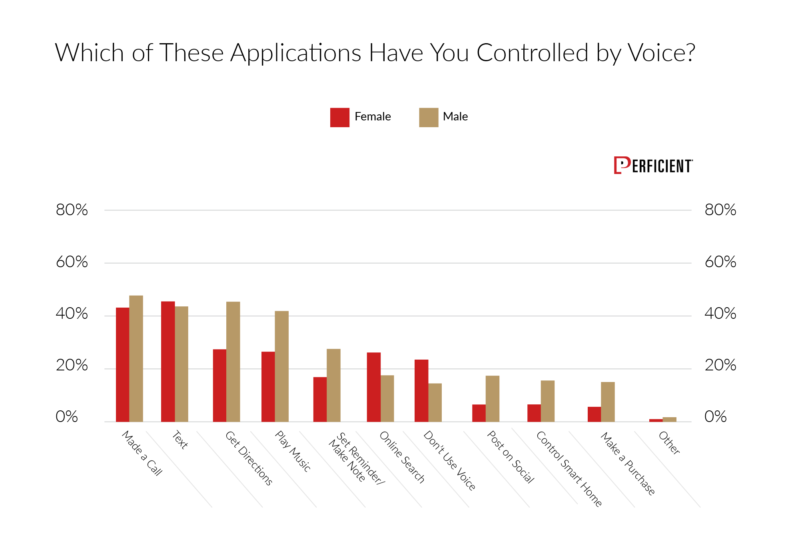
Most notably, men are more likely to play music via voice commands than women by a 42% to 27% margin. But women are more likely to text by voice than men, by a 46% to 33% margin (women are also more likely to use voice for online searches).
The next question explored when people were most likely to use a voice command. The way we phrased the question was, “In which of these situations would you be more likely to use voice commands on your smartphone instead of using your hands? (Please check all that apply).” Here are the results we obtained:
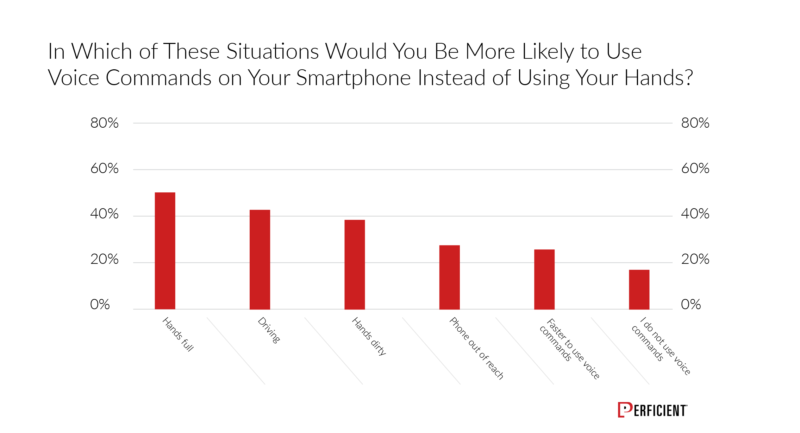
“Hands full” (50%) and “While driving” (42%) were the top two responses. Here is a look at the gender breakout:
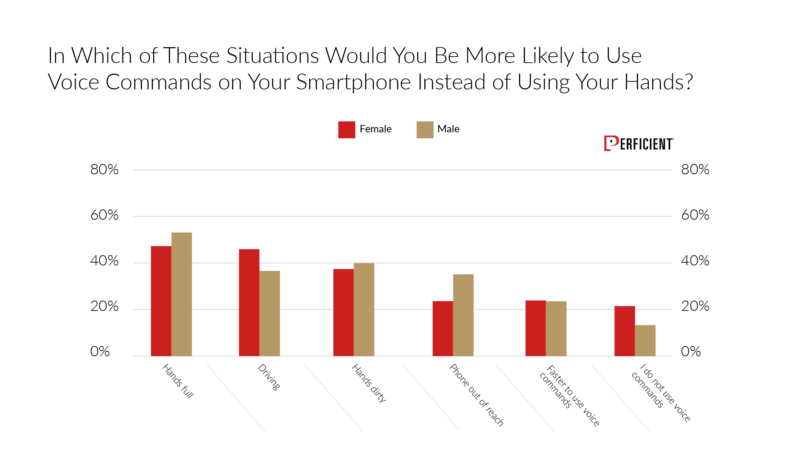
Men also lead most categories here, but 46% of women use voice while driving, compared to 38% of men. We dove a bit more deeply into this area, and asked participants, “How often do you use voice commands while driving?”:
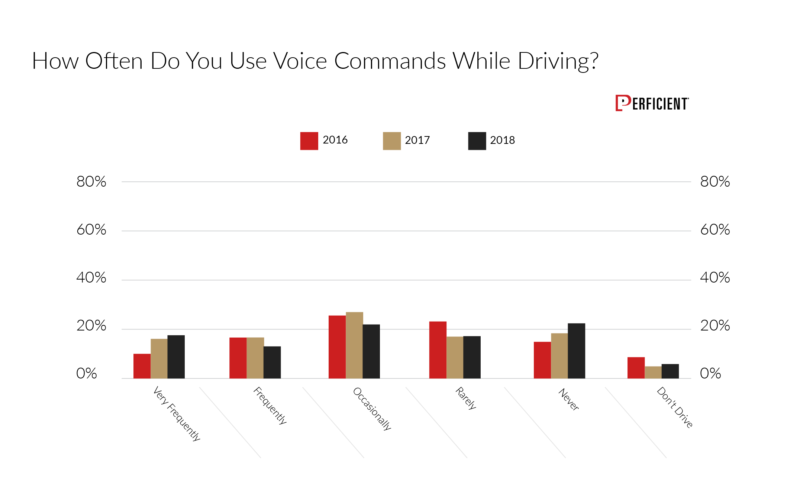 Combining the “Very Frequently” and “Frequently” categories of responses, we get 31%, whereas combining the “Rarely” and “Never” categories returns 41%. This skews towards men, who chose “Very Frequently” or “Frequently” 40% of the time, whereas women did so only 24% of the time. Women chose “Never” or “Rarely” 47% of the time and men only chose one of those 35% of the time.
Combining the “Very Frequently” and “Frequently” categories of responses, we get 31%, whereas combining the “Rarely” and “Never” categories returns 41%. This skews towards men, who chose “Very Frequently” or “Frequently” 40% of the time, whereas women did so only 24% of the time. Women chose “Never” or “Rarely” 47% of the time and men only chose one of those 35% of the time.
Why are people reluctant to use voice commands while driving? We asked them: “Do you think using voice commands while driving is distracting?” The responses were as follows:
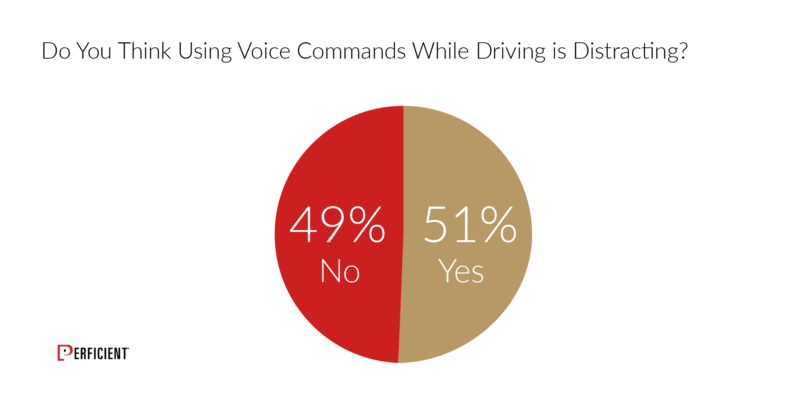
Men are more concerned about this then women by a 56% to 45% margin. Of course, if the law in your state prohibits you from dialing numbers by hand, that may encourage you to use voice for dialing. To find out about that, we asked: “Is there a hands-free driving law in your state?” This is what the participants said:

It’s a bit concerning to see a full 32% indicating that they don’t know. Most states with these laws plaster their highways with signs to make people aware of the law. In fact, there are 16 states that have hands-free restrictions for drivers and their phones.
For our next question, we asked our participants: “How often do you use voice commands with devices other than your phone (e.g. laptop, smart TV, watch, a virtual assistant)?” Here is what they said:
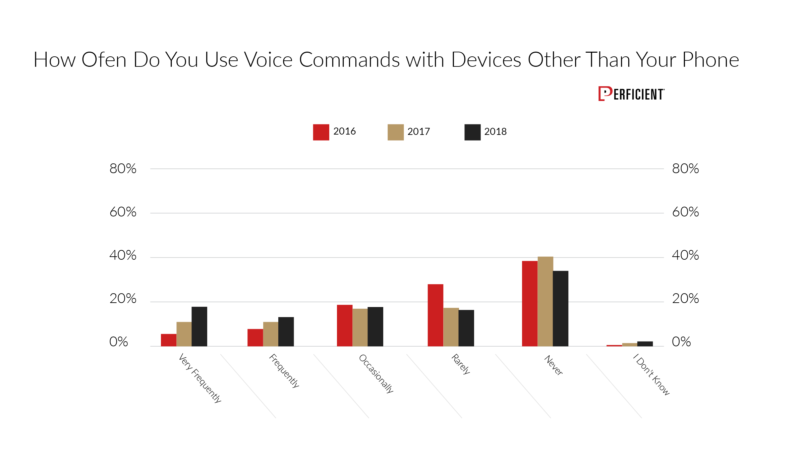
30% of people use voice on other devices “Very Frequently” or “Frequently” (up from 22% last year), and 50% do so “Rarely” or “Never” (down from 58% last year). Interestingly enough, among those who make $100K or more per year, 46% do so “Very Frequently” or “Frequently,” and for the $50K-$99K income range, this still comes in at a strong 39%. This may be due to the growth of the smart speaker market segment. The male bias here is very strong as well, with men outpacing women by a 39% to 22% margin.
We then asked people: “What is your preferred method of sending a text message?” and got the following responses:
 Typing by hand dominates this question (73% of people picked “Type By Hand,” down from 77% in 2018 and 80% in 2017) but using voice to enter in your text is used by 20% of people. Sending your text as a recorded voice message is preferred by 7% of users (up by 4% from last year).
Typing by hand dominates this question (73% of people picked “Type By Hand,” down from 77% in 2018 and 80% in 2017) but using voice to enter in your text is used by 20% of people. Sending your text as a recorded voice message is preferred by 7% of users (up by 4% from last year).
We also wanted to explore basic smartphone usage behaviors. One of the questions we used to do that was: “How do you usually place a call on your smartphone (Please select all that apply)?”. Results were as follows:
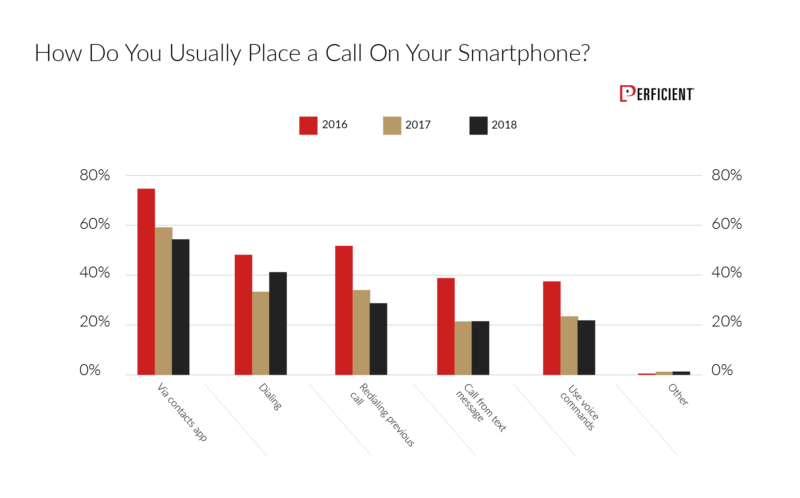
Voice actually came in fourth for this question, with 22% of respondents selecting it. This was a surprise to me, as using voice commands to make calls is a great way to keep your hands on the wheel and eyes on the road while driving.
The next question along these lines explored: “How do you usually talk on the phone (Please select all that apply)?”. Here is what the survey said:
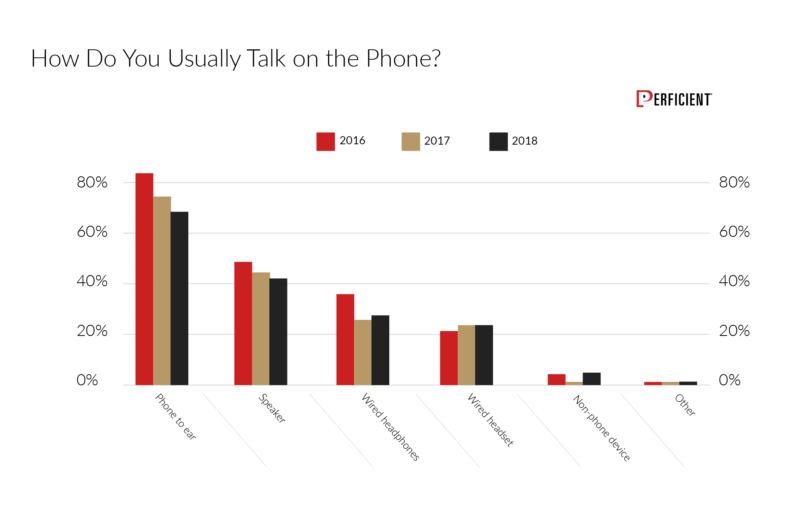 Phone to Ear wins this question at 68%. 43% of people indicated that they use their phones in speakerphone mode, and wired headsets still score well at 28%. Men are far more likely to use a wired headset than women by a 34% to 21% margin. People over 45 are the least likely to use a headset of any kind (21%) compared to their younger counterparts (54%).
Phone to Ear wins this question at 68%. 43% of people indicated that they use their phones in speakerphone mode, and wired headsets still score well at 28%. Men are far more likely to use a wired headset than women by a 34% to 21% margin. People over 45 are the least likely to use a headset of any kind (21%) compared to their younger counterparts (54%).
Our next question was: “When using a search engine or a personal assistant (Google Assistant, Siri or Cortana) on your smartphone, what do you like most about using voice commands (Please rank your top three choices)?” The results were as follows:
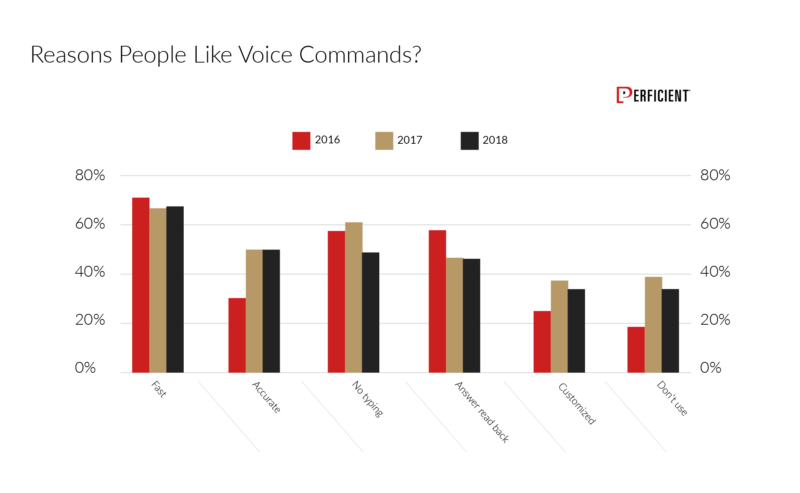
“It’s Fast” was the number one response, with 67% of people selecting it as one of their top three choices. “Accuracy,” “No Typing” and “Answer is Read Back” all scored very close to each other (50%, 49%, and 47%, respectively). Interestingly enough, people with incomes over $100K cited “It’s Fast” as their number one reason 49% of the time (up from 43% last year).
Next up, we asked people about the quality of speech recognition: “How well do your built-in personal assistants on your phone, such as Google Assistant, Cortana, and Siri, understand you?” Here is what we got:
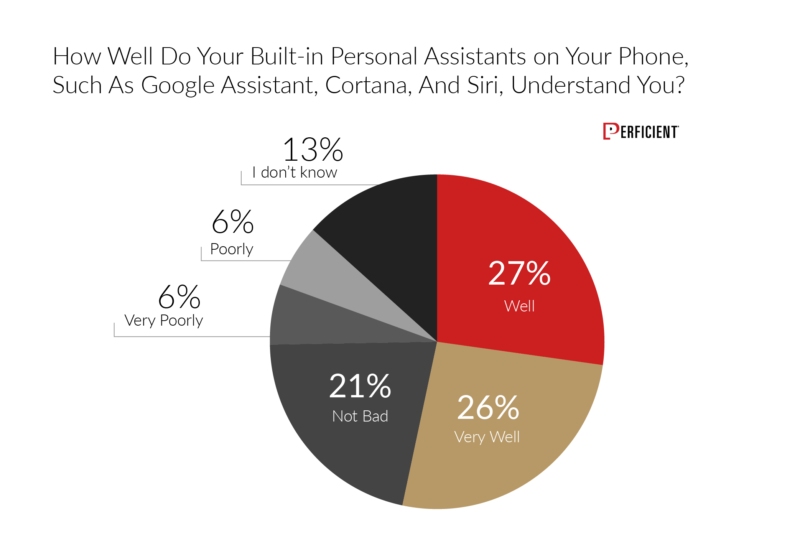
“Very Well” and “Well” came in right at 53%, and when you add “Not Bad,” the total goes up to 74%. The $100K+ income category was at 61% here, and the $50K-$99K category came in at 59%. Men also felt better than women about their devices understanding them by 59% to 48%.
The follow-up question was: “How comfortable are you accessing Siri or Google Assistant by holding down your home button?” Respondents replied as follows:
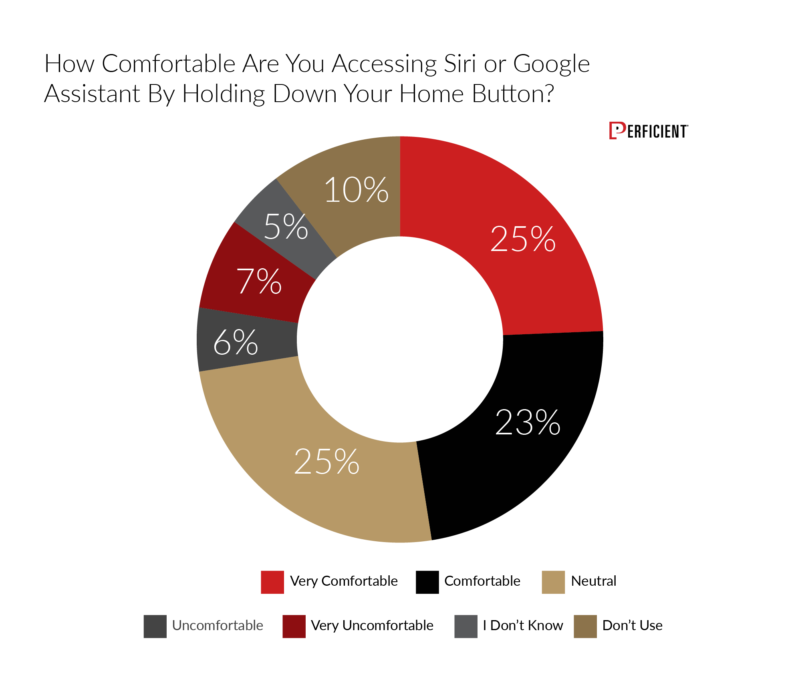
This suggests something interesting about the levels at which people are using personal assistants such as Google Assistant and Siri. 43% of respondents indicated that they are comfortable or very comfortable accessing the phone this way, and only 13% indicated that they are uncomfortable or very uncomfortable.
For users that indicated discomfort, we asked them to clarify why. Responses were as follows:
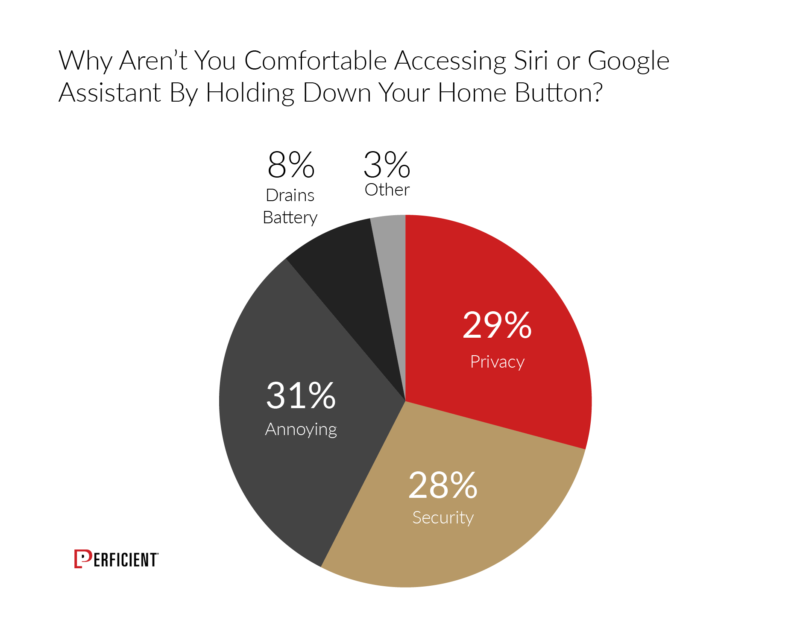
The number one answer? It’s annoying, with a score of 31%. Women are more annoyed by this feature than men by a 37% to 26% margin, whereas men are more concerned about privacy, 35% to 23%.
For our next question, we asked: “Would you use voice to unlock your phone if it were an option?” The responses were as follows:
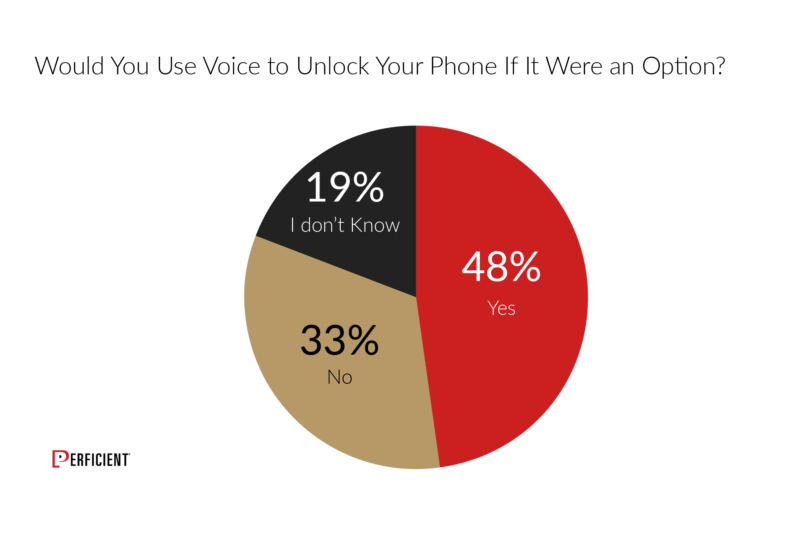
Nearly half say yes, at 48%, with one-third saying no. Higher-income people are much more amenable to this with 59% of people that make $50,000 or more saying that they would use this functionality.
One of the holdups is the reluctance to bother others when we do it. To explore just how real that fear is, we asked, “Do you agree with this statement? I feel annoyed when I hear someone use voice commands on their phone in a public setting.” Here is what people said:
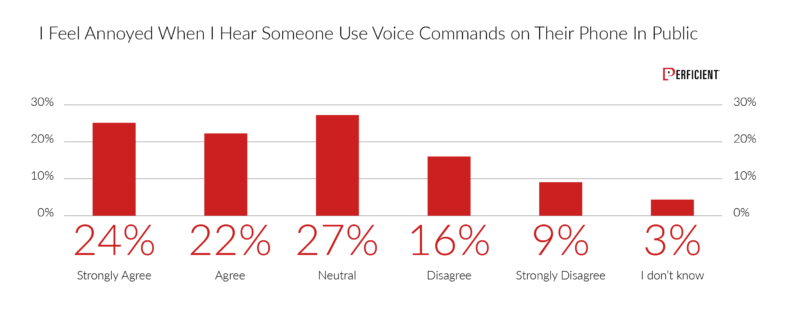
Among respondents, 46% either agree or strongly agree, with only 25% disagreeing or strongly disagreeing. These scores are very similar to last year (at 45% and 25%), so there is still some stigma that remains. This is in spite of the data we presented at the beginning of this report suggesting that people are becoming more comfortable with using voice with their devices in front of others.
This question skews toward higher incomes in a big way, as 61% of those who make $100K+ get annoyed, and 57% of those who make $50-$99K do. You can see the clear trend in this chart:
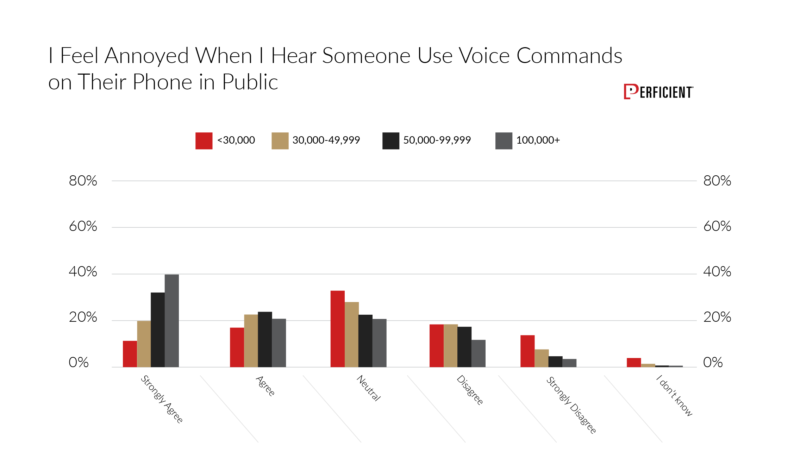
However, it stands to reason that the reason why it’s attractive to use voice commands is that it is convenient. To find out what people thought of that, we asked, “Do you agree with this statement? Voice commands make using my smartphone easier.” Here are the results:

Higher earners appear to see the value more, with 63% of those who make $100K+ strongly agreeing or agreeing with the statement, along with 61% of those in the $50K to $99K income category.
We also wanted to explore what features people want most from their personal assistants in the future. That led us to ask: “When using a search engine or a personal assistant on your smartphone, what features related to voice commands would you like in the future? (Please select all that apply).” This is what the respondents said:
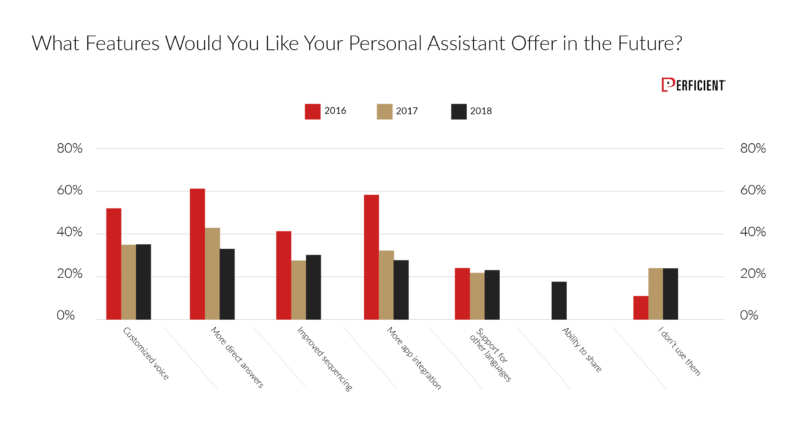
”More Direct Answers” was the winning response in 2016 and 2017, but dropped to second place behind “Customized Voice” in 2018.
For our second-to-last question, we asked, “Are you comfortable activating/accessing Siri or Google using your voice commands, such as Hey Siri, OK Google, or Alexa?”
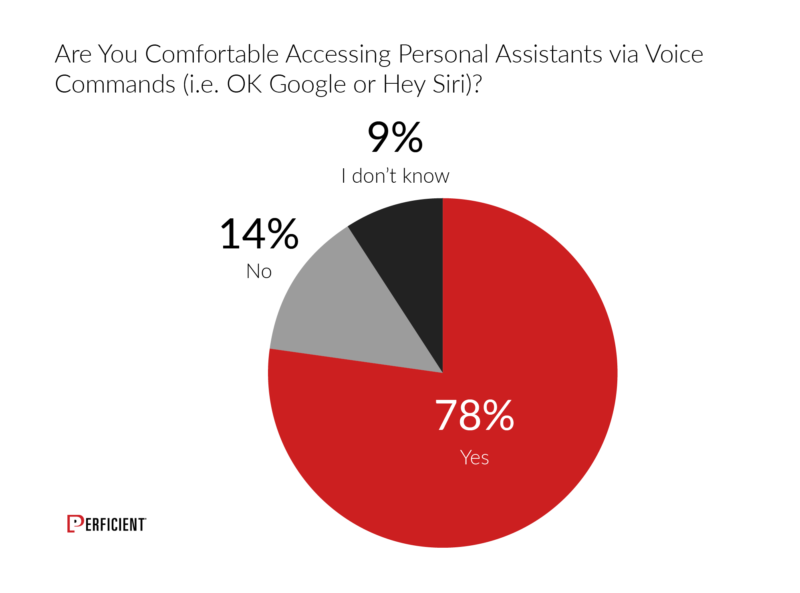
Most people (80%) are pretty comfortable with these commands.
Our final question was grounded in a mistaken impression on our part. We asked people, “Are you aware that all your conversations are recorded when you have ‘Hey Siri,’ ‘OK Google’ or ‘Alexa’ enabled?”
Before presenting the answer, I should clarify that both Amazon and Google have publicly indicated that the recordings of what you say are only kept locally on the device, and they are discarded after six months. This information is not sent back to their data centers. The only information they receive are the actual commands that you provide to the personal assistant. With that clarification, here were the responses:
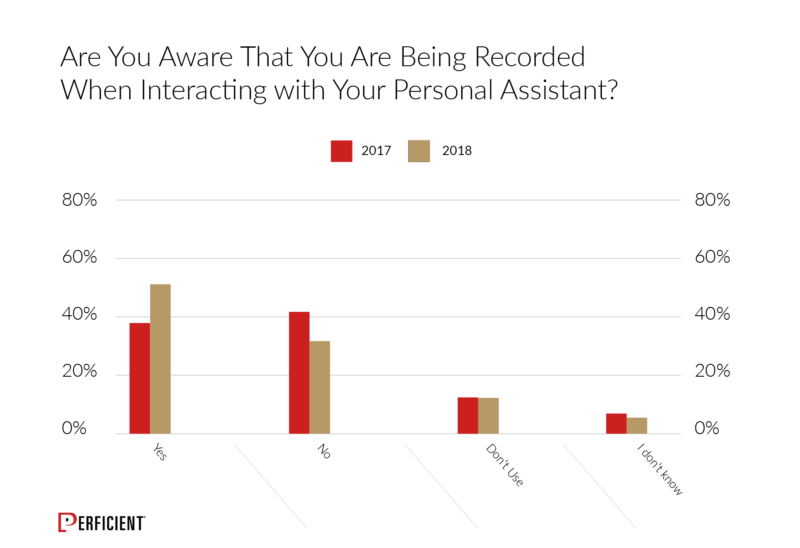
For reference, here are articles that provide some background on the information retention policies of Amazon and Google:
- Can Amazon Testify Against You?
- Relax, Your Amazon Echo Isn’t Recording Everything You Say
- How Google Home’s ‘Always on’ Will Affect Privacy
Summary
That was a lot of data to read (and to process!), but as a digital marketer, it’s important to understand how quickly the voice revolution is coming. There are four primary trends driving this:
-
- People are becoming accustomed to using voice commands with their devices. Our voice usage studies have shown this progressing steadily for the past three years.
- The rise of the Internet of Things. 77% of all internet-connected devices will be something other than a tablet, PC or smartphone by 2020. Many of these devices will be browser-less.
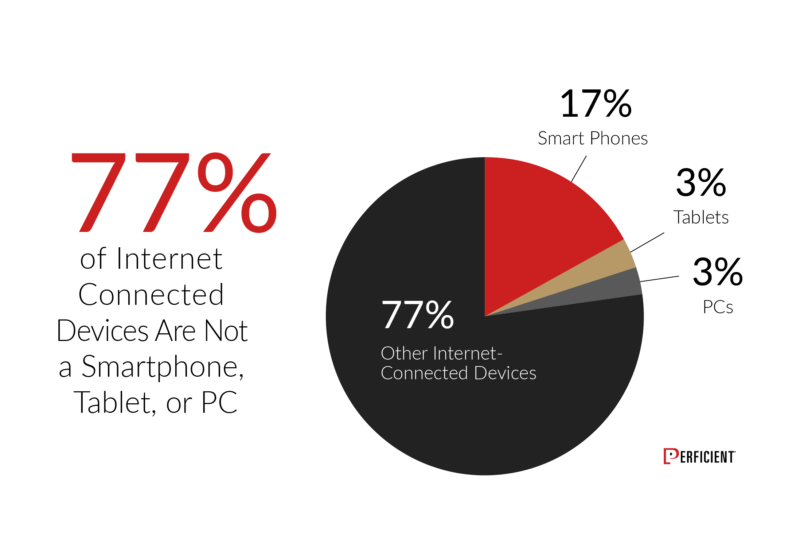
- The rise of digital personal assistants. Apple has announced that Siri is used on over 500 million devices, and Google has indicated that it has active users for Google Assistant on 400 million devices. As their usefulness grows, adoption will scale, and the presumptive interface will be voice.
- The rise of smart speakers. Sometimes a revolution needs a spark to start it, and the smart speaker market explosion now in progress may be just that. Here are the figures on smart speakers’ level of penetration, according to comScore.
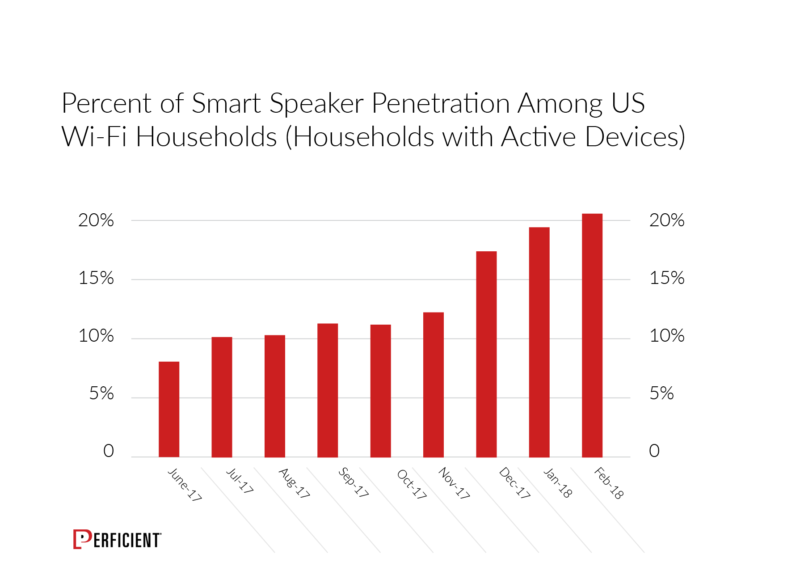
How fast will we reach a billion users who view voice as one of the primary methods for interacting with their devices? I believe we’ll be there in less than five years. This is a large and disruptive market change, so the time to start thinking about this is now.

